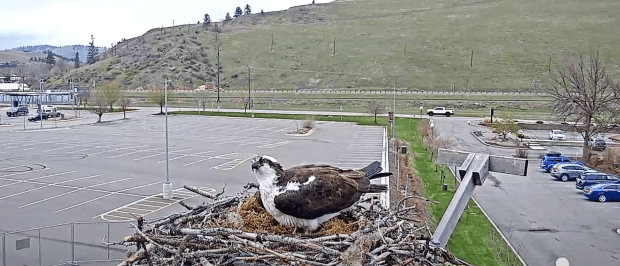3 May 2022
The trouble with intruders into established nesting territories is that they can cause a lot of grief and, as we have seen, they can cause part of a bonded nesting couple to die. We saw this with Grinnell at UCalifornia-Berkeley Falcons. We saw it at the Bald Eagle nest of Bella and Smitty when Bella was injured and feared dead when a female intruder attacked her. Bella returned. A week ago Harry disappeared at the Minnesota DNR Bald Eagle Nest. There have been intruders since last year on and off the Achieva Osprey nest. The list goes on and on. The success of restoring the Eagles, the Ospreys, and the hawks and falcons after DDT (DDE) destroyed their populations (along with egg collecting, feathers for hats, shootings, habitat destruction) has resulted in a growing population where there are challenges for the best territories and mates. At the same time, what you have witnessed here and at other nests is troublesome.
Intruders without nests and mates are now wrecking havoc at the UFlorida-Gainesville Osprey nest. It is possible that this has been the issue for most of the nesting season when the male has not been able to bring adequate prey to the nest because of territorial surveillance and the removal of intruders. One chick lost and not enough food for three coming to the nest – Mum and two chicks.
The Mum left the nest at 15:25 on 2 May not returning until today. That same female intruder landed on the nest with the chicks this morning who, in their hunger, kept crying for her to feed them. She didn’t and she nipped at the Middle chick who was trying to get near to get a few bites. The chicks were confused. Dad flew in with a fish at 10:31, left, returned with a partial fish at 10:47, and was in a general state of anxiousness. Still the chicks cried for food.
In the image below Mum is on the nest. She returned with a full crop at 12:42. See the birds below the nest? That is Dad chasing away the female intruder.

Mum was attacked and now Dad is chasing off the intruder – this is a very good explanation for what has been happening on this nest. It is interesting to me, at least, that the causes of siblicide do not mention ‘intruders’.
I want to thank ‘A’ and ‘R’ who watched this nest while I was away.
‘A’ makes note of the intruder attacking the female at 12:57. ‘A’ also observed a fish, not a large one, being delivered at 14:43 where both of the chicks were fed.
From ‘R’s observations there appear to be issues with the intruder during this feeding. ‘R’ notes that “at 1501:10 you see two shadows very close together and Mum appears very nervous and stops feeding chicks and starts pulling the fish around the nest. At 1508:35 she becomes agitated and appears ready to fly off the nest but settles down and starts feeding the chicks again.” Clearly the intruder is making the nesting birds nervous causing them to react and not focus on the chicks. ‘R’ notes that following a couple of aggressive behaviours, Middle manages to get the remainder of the fish. Well done, Middle! Most of the time it is to Big’s advantage. Clearly another bird flying around as you can see the shadow pass the nest on multiple occasions.
Once Dad has dispensed with the female intruder, he returned with a large headless fish at 16:28. This is excellent and this is the way to get a nest back on track. Let us hope that the intruder has decided to go elsewhere.
There was a bit of a tussle between the two chicks once the fish had landed. I noted that each stood up to the other. Middle is hungry enough he might go on the attack.

I was surprised when Middle stood up big and bold that the two birds are not that much different in size. Clearly Big has the advantage of being energized by more food and is stronger.

Big exerts its dominance but this does not stop Middle from exerting its presence to get fed.

‘R’ noted that Mum moved the fish to the opposite side of the nest whiich was more advantageous to Middle. Once Mum got settled things began to get sorted with the feeding. In the end I would say that both chicks ate well.


It is 16:56 and both of the chicks are being fed in almost equal portions and there is still fish remaining. We can all sleep sound knowing that Middle had a really good feed late today!

Mum is still feeding at 17:01. How grand.

Each was offered a piece of fish tail at the end. Both osplets have crops. Nice.

I cannot think of a nicer way to end this blog. Despite all of the commotion and potential danger to this nest, in the end, Dad came through with a big enough fish for both of them to eat well. Sometimes we have to take the nests a day or an hour at a time. Today was a good day for Middle – and for Big.
Thank you so much, ‘A’ and ‘R’. You have each helped to fill in the gaps while I was away and to add substance to the angst that this intruder has caused. Much appreciated.
Thank you so much for joining me. Take care everyone.
Thank you to the UFlorida-Gainesvlle Osprey streaming cam where I took my screen captures.










































































































































































